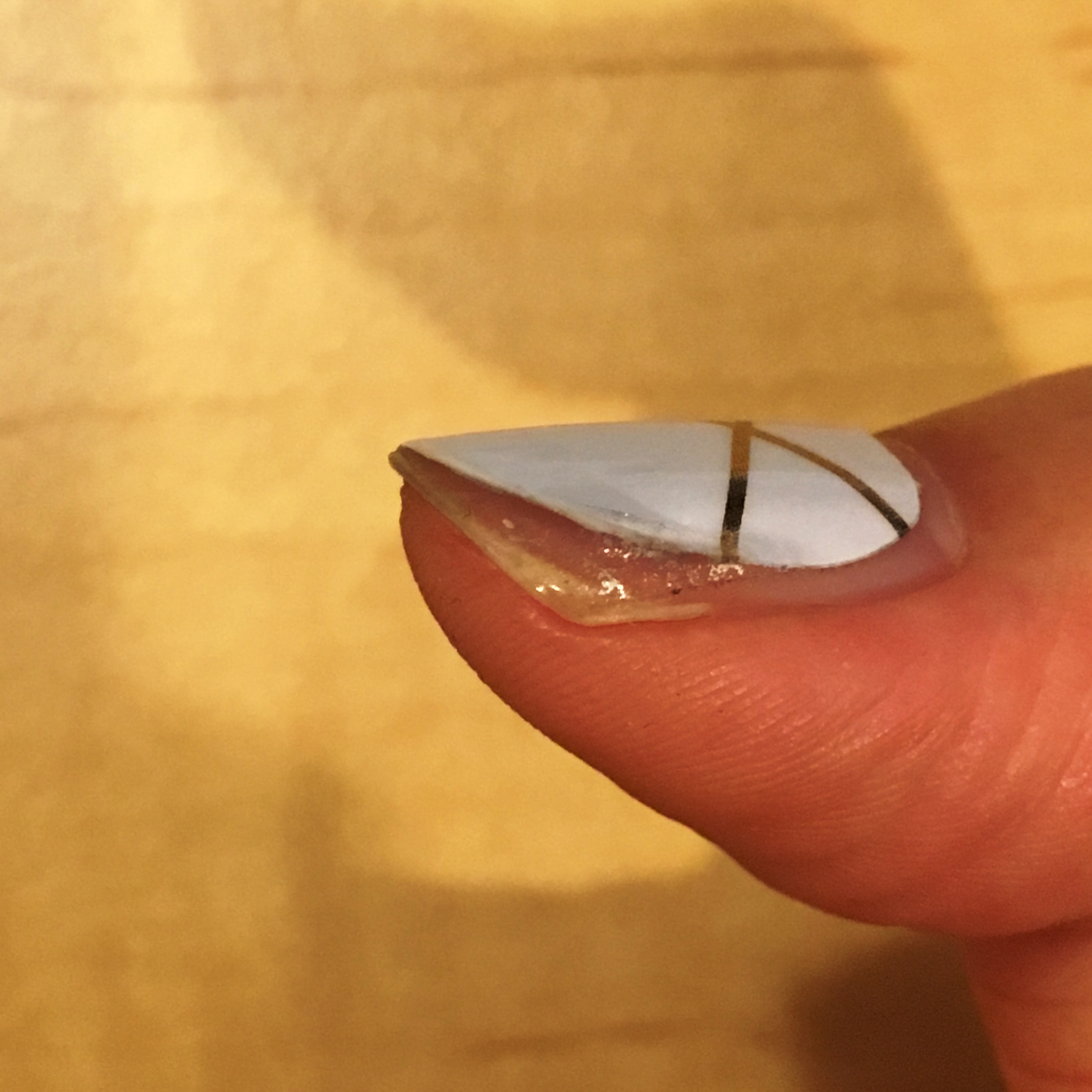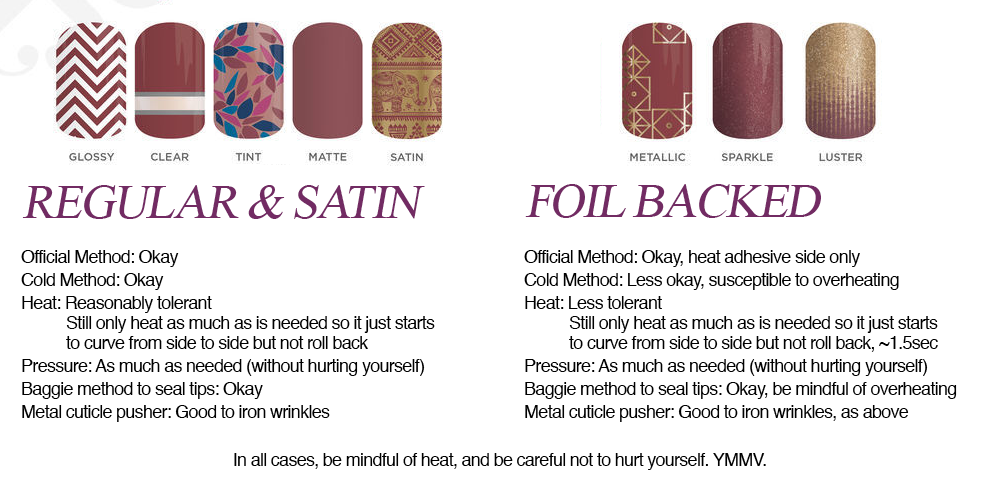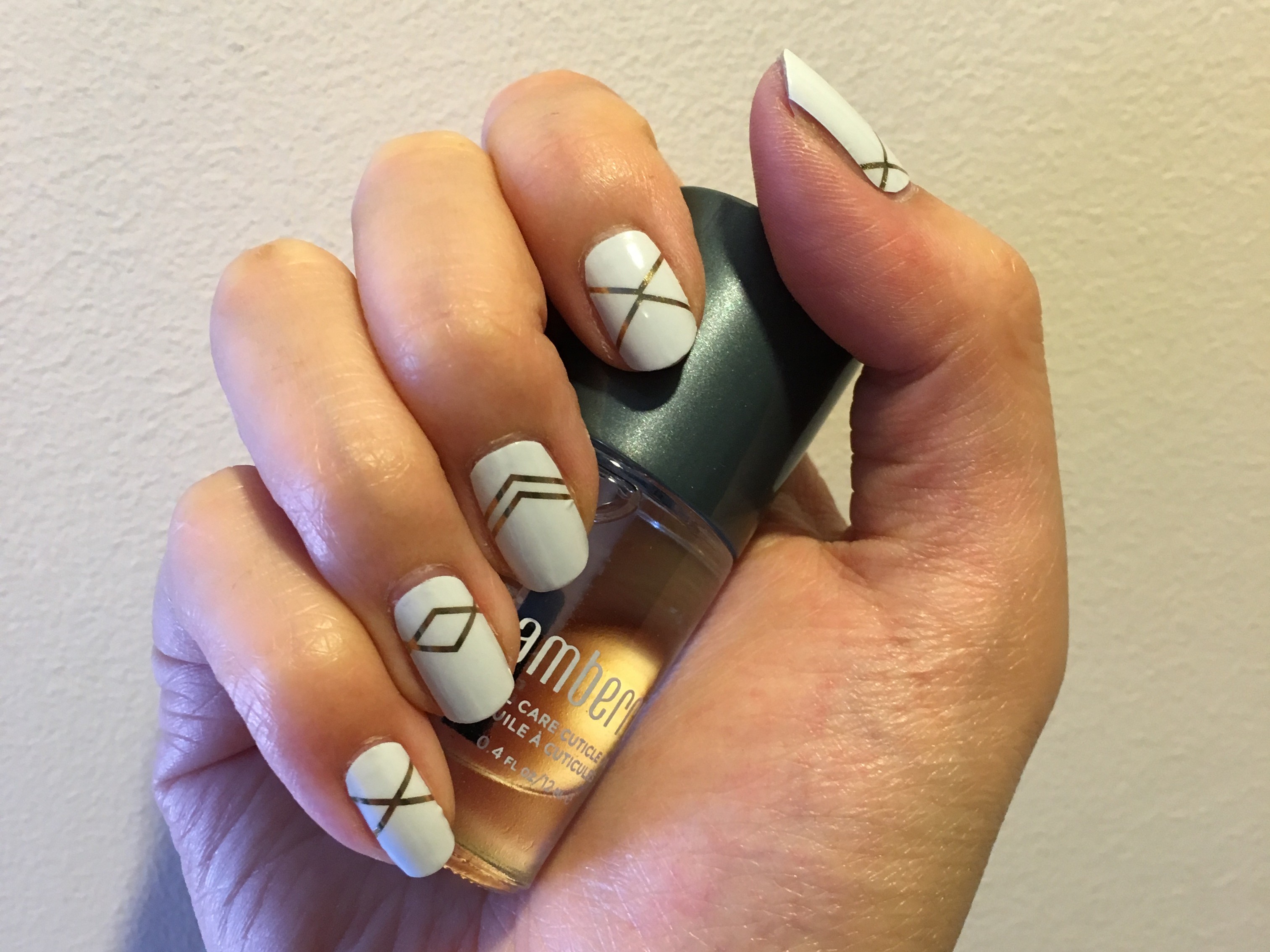The Great and Pernickety Gatsby
Gatsby, one of Jamberry's most popular wraps, has proved to be as eccentric as its namesake.
It's classified as a Metallic finish, and is thicker than some of the other finishes due to the layering of non-metallic elements. But don't be fooled by its thickness, for application, this finish needs less heat, not more.
Overheating
How do you know if you've overheated your wraps? Oh. Don't worry, you'll know.

I apologise for the graphic nature of this image, but you need to see this horror so that you may avoid it for yourselves.
What you're seeing is an overheated metallic wrap. The adhesive layer will be firmly attached to your nail with a thin layer of the metallic design visible, but the rest of the wrap will have separated, lifting and curling away from the edges, usually the tip.
Depending on how badly it has been overheated, you may see this within an hour of application, or not until the next morning. Once the layers have separated, the split will worsen over time, and is irreparable short of using nail glue.
The cause of my problems with this application were manifold:
- Rushing I misjudged how much time I had before I had to leave for a dinner engagement, and I rushed my application to get both hands done. Take your time. If you only have time to put on part of a manicure before you have to dash off, just stop and pick up again later. That's one of the benefits of Jamberry after all.
- Not understanding how much heat was too much I tried to be cautious with overheating, but the guideline I was given of "use less heat than normal" was about as useful as being told to "add enough flour until it feels right" in a gnocchi recipe for someone who hasn't made gnocchi before.
- Heating from the wrong side The official application method heats from the adhesive side. But alternate application methods have you heating the wrap from the design side once it has been placed on your nail. I was using the latter. Due to the thickness of the wrap, heating from the design side creates a higher risk of overheating the wrap.
Application Tips
After that kerfuffle, I did a bit of research about the application of Gatsby, and other wrap finishes, and came up with this:

If you're using a heating method that isn't the mini-heater, you may have to adjust that timing of ~1.5 seconds. For a visual cue, you only want it to heat just enough for it to start to curve from side to side, but not enough to make the wrap curl or roll upwards. But don't freak out if it does curl upwards. Depending on the thickness of the wrap, this margin can be very narrow, but it does not mean the end of the world, and just carry on with your application. :)
Note: If you use the cold application method, I've heard from one of my friends that you can get positive results from applying the heat sideways so the heat gets under the wrap, rather than directly to the top of the design.
Although you're using less heat, you'll need to apply more pressure. Use your thumbs, or a cuticle pusher/orange stick to create a good seal around the edges by pressing down, and not rubbing too hard. Rubbing or sideways pressure can stretch the wrap and cause puckering. If you're using the anti-baseball or pulling method for domed nails, make sure you allow the wrap enough time to cool for the stretch to recover a bit before you cut and/or file.
To seal the tips, you can use the baggie method, or a heated metal cuticle pusher or tweezers to iron out wrinkles, but again, be careful not to overheat, and apply more pressure to the wrap after you do these things to make sure it's all sealed properly.
Defective batch, or not?
There were suggestions that the separation with Gatsby may have been due to a defective batch of wraps as there were more cases being reported than expected within a relatively short period of time, and I actually had my first sheet of Gatsby replaced by Jamberry after showing them that picture above (how great is that service). The featured image at the top of this post is a manicure using the replacement sheet with the tips above. This lasted a full week (and still looked fine) before I decided to put on a manicure from the first sheet again so that I could confirm whether it was a batch issue or an application issue.

This manicure is using the sheet that initially failed using the same application method as with the replacement sheet. It looked fine all the first day, but on the second, I started to notice lifting on my dominant hand, though not so much on my non-dominant hand. On the third, lifting was quite severe on both hands. So it does look as though there may have been a defective batch of Gatsby.
Regardless, keep to those tips above, and if you experience the splitting issue with any foil-backed wraps, take a photo, and contact your consultant about referring this issue to Jamberry support. Jamberry are committed to ensuring their products and customer service are of the highest standard, so do please tell your consultant if you have any problems.
Final Notes
Nail Ridges and Thicker Wraps
You'll notice a small bubble at the tip of my middle finger in the image above. I have quite prominent ridges on some of my fingers, such that you can actually see the ridge line running from the bubble up to my cuticle. As a result, I'm finding that thicker wraps aren't sitting as smoothly because they're not thin enough to 'go with the flow' so to speak. This does not affect the overall seal of the wrap, however if you have ridges and work in an area such as medical or food prep where bacterial risk is a concern when bare-handed, avoid thicker wraps. For slight ridges, a light buff may help even out the surface.
At a glance, this level of imperfection isn't noticeable, so I'm not bothered by it.
Not Your Every Day Wraps
Also, for reference, I consider these metallic wraps (and some matte wraps) to be for events or occasions. While they're generally hardy in terms of staying on for the advertised 'up to two weeks', if you do a lot of work with your hands, these are more inclined to show wear. So aesthetically speaking, they are less likely to go the long haul before you'll want to take them off.
This of course will vary on an individual basis, as I've quite successfully worn a mixed mani of satin (Renaissance) and lustre (Venice) which lasted a full two weeks with only minor tip maintenance after the first week.
It isn't going to stop me wearing these more glam designs day-to-day, but I won't be disappointed if they don't last the full two weeks.
